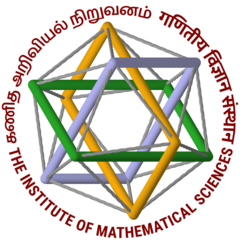Computational Biology Webinars


| Speaker: | Ganesh Bagler |
|---|---|
|
Indraprastha Institute of Information Technology (IIIT), Delhi | |
| Date: | July 30, 2020 |
| Time: | 16:00 - 17:00 |
| Speaker: | Shyam K. Masakapalli |
|---|---|
|
Indian Institute of Technology (IIT), Mandi | |
| Date: | August 4, 2020 |
| Time: | 16:00 - 17:00 |
| Speaker: | Guillermo Restrepo |
|---|---|
|
Max Planck Institute for Mathematics in the Sciences, Leipzig, Germany | |
| Date: | August 6, 2020 |
| Time: | 15:00 - 16:00 |
| Speaker: | Ashutosh Srivastava |
|---|---|
|
Institute of Transformative Bio-Molecules, Nagoya University, Japan | |
| Date: | August 11, 2020 |
| Time: | 16:00 - 17:00 |
| Speaker: | Uddipan Sarma |
|---|---|
|
Vantage Research, Chennai | |
| Date: | August 13, 2020 |
| Time: | 15:00 - 16:00 |
| Speaker: | Sudip Kundu |
|---|---|
|
University of Calcutta, Kolkata | |
| Date: | August 18, 2020 |
| Time: | 16:00 - 17:00 |
| Speaker: | Sangram Bagh |
|---|---|
|
Saha Institute of Nuclear Physics (SINP), Kolkata | |
| Date: | August 20, 2020 |
| Time: | 16:00 - 17:00 |
| Speaker: | Zhumur Ghosh |
|---|---|
|
Bose Institute, Kolkata | |
| Date: | August 25, 2020 |
| Time: | 15:00 - 16:00 |
| Speaker: | Ram Rup Sarkar |
|---|---|
|
CSIR-National Chemical Laboratory, Pune | |
| Date: | August 27, 2020 |
| Time: | 16:00 - 17:00 |
| Speaker: | Amit Ghosh |
|---|---|
|
Indian Institute of Technology (IIT), Kharagpur | |
| Date: | September 1, 2020 |
| Time: | 16:00 - 17:00 |
| Speaker: | Saurav Mallik |
|---|---|
|
Weizmann Institute of Technology, Israel | |
| Date: | September 8, 2020 |
| Time: | 16:00 - 17:00 |
| Speaker: | Debarka Sengupta |
|---|---|
|
Indraprastha Institute of Information Technology (IIIT), Delhi | |
| Date: | September 15, 2020 |
| Time: | 16:00 - 17:00 |
| Speaker: | Shailaza Singh |
|---|---|
|
National Centre for Cell Science (NCCS), Pune | |
| Date: | September 22, 2020 |
| Time: | 16:00 - 17:00 |
| Speaker: | Biplab Bose |
|---|---|
|
Indian Institute of Technology (IIT), Guwahati | |
| Date: | September 24, 2020 |
| Time: | 16:00 - 17:00 |
| Speaker: | Mohit K. Jolly |
|---|---|
|
Indian Institute of Science (IISc), Bengaluru | |
| Date: | October 1, 2020 |
| Time: | 16:00 - 17:00 |
| Speaker: | Sucheta Gokhale |
|---|---|
|
TATA Chemicals, Pune | |
| Date: | October 6, 2020 |
| Time: | 15:00 - 16:00 |
| Speaker: | R.K. Brojen Singh |
|---|---|
|
Jawaharlal Nehru University (JNU), New Delhi | |
| Date: | October 9, 2020 |
| Time: | 16:00 - 17:00 |
| Speaker: | Vinod Scaria |
|---|---|
|
Institute of Genomics and Integrative Biology (IGIB), Delhi | |
| Date: | October 15, 2020 |
| Time: | 16:00 - 17:00 |
| Speaker: | Marcin Zagorski |
|---|---|
|
Jagiellonian University, Kraków, Poland | |
| Date: | October 20, 2020 |
| Time: | 15:00 - 16:00 |
| Speaker: | Shaon Chakrabarti |
|---|---|
|
National Centre for Biological Sciences (NCBS), Bengaluru | |
| Date: | October 22, 2020 |
| Time: | 15:00 - 16:00 |
| Speaker: | Pan Jun-Kim |
|---|---|
|
Hong Kong Baptist University, Hong Kong, China | |
| Date: | October 27, 2020 |
| Time: | 16:00 - 17:00 |
| Speaker: | Andrea De Martino |
|---|---|
|
Researcher, CNR Nanotech and Institute of Genomic Medicine, Italy | |
| Date: | October 29, 2020 |
| Time: | 15:00 - 16:00 |
| Speaker: | Anshu Bhardwaj |
|---|---|
|
CSIR-Institute of Microbial Technology, Chandigarh | |
| Date: | November 5, 2020 |
| Time: | 15:00 - 16:00 |
| Speaker: | Anu Raghunathan |
|---|---|
|
CSIR-National Chemical Laboratory, Pune | |
| Date: | November 12, 2020 |
| Time: | 15:00 - 16:00 |
| Speaker: | R. Sowdhamini |
|---|---|
|
National Centre for Biological Sciences (NCBS), Bengaluru | |
| Date: | November 17, 2020 |
| Time: | 15:00 - 16:00 |
| Speaker: | Fakhteh Ghanbarnejad |
|---|---|
|
Sharif University of Technology, Tehran, Iran | |
| Date: | November 19, 2020 |
| Time: | 15:00 - 16:00 |
| Speaker: | Kavita Jain |
|---|---|
|
Jawaharlal Nehru Centre for Advanced Scientific Research (JNCASR), Bengaluru | |
| Date: | November 24, 2020 |
| Time: | 15:00 - 16:00 |
| Speaker: | Harapriya Mohapatra |
|---|---|
|
National Institute of Science Education and Research (NISER), Bhubaneswar | |
| Date: | December 8, 2020 |
| Time: | 15:00 - 16:00 |
| Speaker: | Chirag Jain |
|---|---|
|
Indian Institute of Science (IISc), Bengaluru | |
| Date: | December 10, 2020 |
| Time: | 15:00 - 16:00 |
| Speaker: | Kalyan Sundar Chakrabarti |
|---|---|
|
KREA University, Andhra Pradesh | |
| Date: | December 17, 2020 |
| Time: | 15:00 - 16:00 |
| Speaker: | Sutirth Dey |
|---|---|
|
Indian Institutes of Science Education and Research (IISER), Pune | |
| Date: | December 22, 2020 |
| Time: | 15:00 - 16:00 |